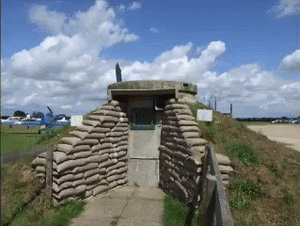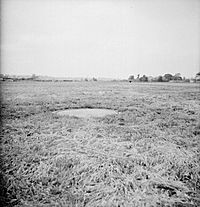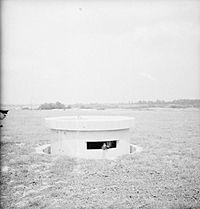Pickett-Hamilton fort facts for kids
Quick facts for kids Pickett-Hamilton fort |
|
|---|---|
| Lashenden Air Warfare Museum | |

Pickett-Hamilton fort excavated and reconstructed above ground for public display
|
|
| Type | Pillbox |
| Site history | |
| In use | Second World War |
| Materials | Concrete |
A Pickett-Hamilton fort was a special type of hidden bunker. It was built in Britain during the Second World War (1940–1941). These forts were designed to be lowered into the ground. This made them hard to see and kept them from blocking planes or vehicles.
When needed, the fort could be raised about 2.5 feet (0.76 meters) above the ground. From this position, a small crew could use rifles or light machine guns. This helped protect airfields from enemy attacks.
Contents
How the Forts Were Designed
Most Pickett-Hamilton forts were made of two concrete cylinders. The smaller cylinder fit inside the larger one. Small rollers helped it slide smoothly. The fort was buried so the top of the smaller cylinder was level with the ground.
When it was hidden, planes and vehicles could drive right over it. This made the fort very hard to spot.
Getting Inside and Raising the Fort
To get inside, soldiers used a small hatch and rungs. To make the fort ready for action, a lifting system was used. This system raised the inner cylinder about 2.5 feet (0.76 meters). When raised, three openings, called embrasures, appeared. Two soldiers could then operate the fort as a small bunker.
Different Lifting Systems
At first, a standard airplane jack was used to lift the fort. This took about three minutes. Soon, a faster system was introduced. It used a pneumatic ram, which worked with compressed air. This allowed the fort to be raised and lowered quickly. A hand pump was also included as a backup. It could be used for daily checks or if the main system failed.
Another design used heavy counterweights to raise the fort. This meant soldiers could lift it using their own strength. This version had two hatches and a slightly larger underground room. It could hold a crew of four soldiers. However, only about a dozen of these were ever installed.
Where You Can See Them Today

Many of these forts were moved from their original spots. This happened because they often flooded. Also, they were not strong enough for the heavier planes used later in the war. Records show that 335 forts were built. Today, 48 examples still exist.
You can see some Pickett-Hamilton forts at museums. These include the Tangmere Military Aviation Museum and the Lashenden Air Warfare Museum. There is also one at the D-Day Museum, Southsea. An inner part of a fort is at the Imperial War Museum Duxford.
Because these forts could hide underground, many were lost over time. They were only rediscovered years later.
The Restored Fort at Lashenden
The Kent International Airport (once called RAF Manston) gave a Pickett-Hamilton fort to the Lashenden Air Warfare Museum. Most surviving forts are filled with water. But the one from Manston was dry and in great shape.
Museum members worked for 18 months to dig it up and restore it. They even got the lifting system working again. The fort was originally meant to be buried. However, to protect the concrete, it was placed at ground level. It is surrounded by earth and sandbags. Visitors can put a coin in a slot to see the lifting mechanism in action. This is the only fully restored Pickett-Hamilton fort that still works.



